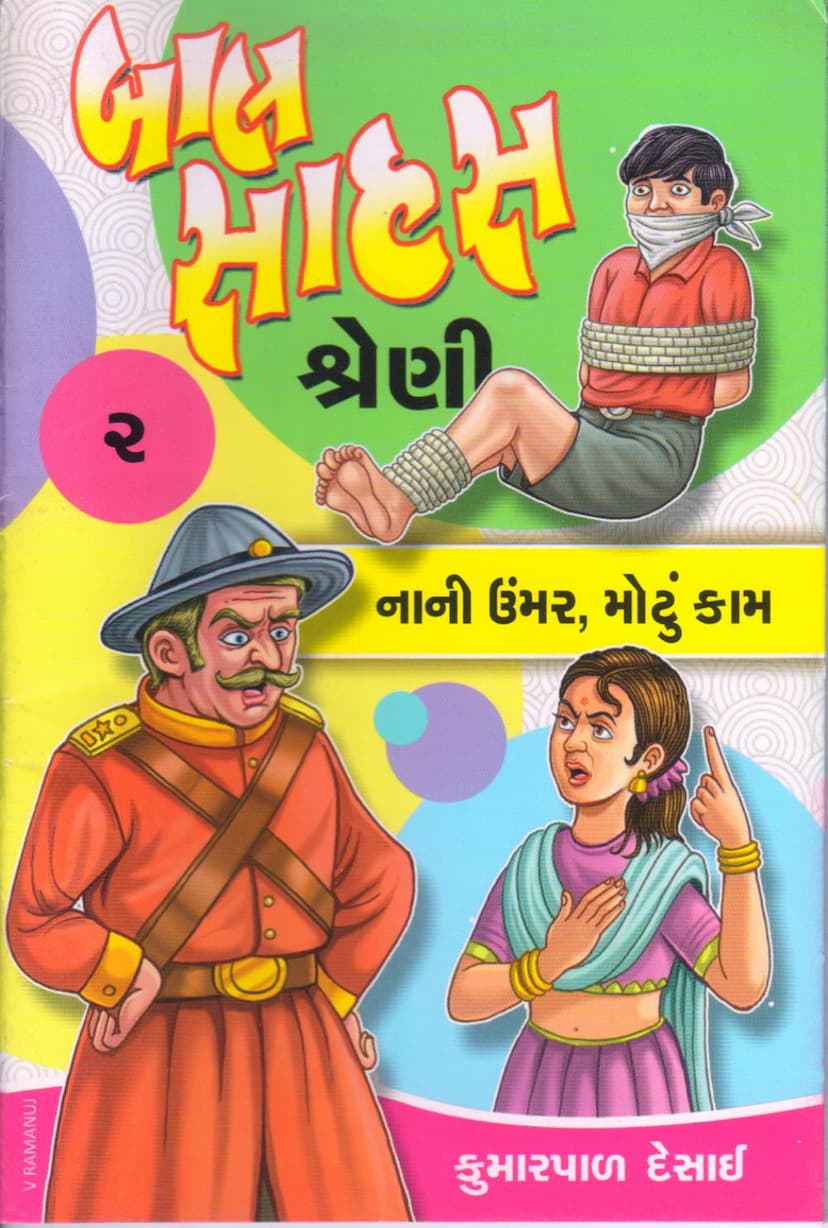Nani Umar Motu Kam
Added to library: September 2, 2025

Summary
This document is a summary of the Jain book "Nani Umar, Motu Kam" (Small Age, Big Work) by Kumarpal Desai, published by Gurjar Sahitya Prakashan. The book is a collection of inspiring stories about children who have demonstrated courage, presence of mind, and bravery in challenging situations.
Here's a breakdown of the content based on the provided pages:
Introduction and Author's Note (Page 3): The author, Kumarpal Desai, states that the book features stories of children from familiar settings in India. The aim is to instill a spirit of courage and adventure in young readers. The stories are based on true events showcasing the intelligence, bravery, and quick thinking of children. The author emphasizes that children can easily relate to the experiences of peers their own age, which can inspire them to act bravely in difficult times. The book's revised edition received an award for best book in the 21st National Children's Literature Competition organized by the Government of India. The author expresses gratitude to Gurjar Granth Ratna Karyalaya and Shri Manubhai Shah for their support in the publication.
Table of Contents (Page 4): The book contains the following stories:
- Gangate ane Chocho (Gangate and Chocho)
- Nani Umar, Motu Kam (Small Age, Big Work)
- Darvu ne Marvu Sarkhu (To be Afraid is Like Dying)
- Manavta no Saad (The Call of Humanity)
Story 1: Gangate ane Chocho (Gangate and Chocho) (Pages 4-8): This story narrates the incident of a 4-year-old boy named Lala Gangate and his 1.5-year-old friend Chocho. While playing near a pond, Chocho falls into the water. Gangate, despite his young age and the absence of any adults, tries to rescue his friend. When he cannot pull Chocho out by himself, he runs to a nearby house and fetches help from an adult. The adult successfully rescues Chocho. This act of bravery and quick thinking by Gangate earned him recognition, including an award presented by the Prime Minister of India, who stated that such brave and intelligent children are the true wealth of the nation.
Story 2: Nani Umar, Motu Kam (Small Age, Big Work) (Pages 9-13): This story details the courageous act of a 9-year-old boy named Naveenchandra Ghosh in the 24 Parganas district. During a night when dacoits attacked their village, Naveenchandra's father, Panchanan Ghosh, a brave man, resisted the robbers. Despite being outnumbered and injured, Panchanan fought back. Naveenchandra, witnessing his father's struggle and the dacoits' brutality, bravely snatched a gun from one of the dacoits. He then used his marksmanship skills, learned from his father, to shoot and kill the dacoit leader and injure several others. His actions repelled the dacoits and saved the village. Naveenchandra was honored with the title 'Veer Balak' (Brave Child) by the Indian government.
Story 3: Darvu ne Marvu Sarkhu (To be Afraid is Like Dying) (Pages 13-18): This story is about a 9-year-old boy named Mukesh who studies in Ghatkopar Gurukul Vidyalaya, Mumbai. On January 19, 1974, after school, a stranger approached Mukesh and falsely claimed his father had an accident. Mukesh, despite his young age, displayed sharp wit by refusing to go with the stranger without informing his mother. The stranger then forcefully abducted Mukesh and tied him up in a building under construction. However, Mukesh, demonstrating great courage and intelligence, managed to crawl down the stairs despite his bound hands and feet. He was found by a security guard who took him to the police station. Meanwhile, Mukesh's parents were worried and had reported him missing. The police later arrested the kidnapper, Chandrasen Ashar, who intended to demand a ransom. Mukesh's presence of mind and bravery thwarted the criminal's plan.
Story 4: Manavta no Saad (The Call of Humanity) (Pages 18-22): This story recounts the bravery of a 14-year-old boy named Babu Punna during the August 1973 floods in Gujarat. The Mahi River overflowed, submerging villages and trapping around two thousand people on trees. With no means of communication or rescue, Babu, who had a strong affinity for water and was an experienced swimmer and boatman, decided to act. He bravely navigated his small boat through the treacherous floodwaters, facing strong currents, debris, and whirlpools. He reached the other side of the river and informed the authorities. Military rescue boats were dispatched, and Babu's courage helped save the lives of the trapped villagers. The story highlights Babu's humanitarian spirit and courage in answering the call of humanity.
In essence, "Nani Umar, Motu Kam" is a collection of real-life accounts that aim to inspire young readers by showcasing the remarkable courage, intelligence, and resilience of children, proving that age is not a barrier to performing great deeds.